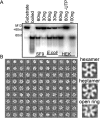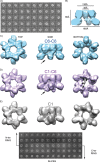The hexameric structure of the human mitochondrial replicative helicase Twinkle
- PMID: 25824949
- PMCID: PMC4417153
- DOI: 10.1093/nar/gkv189
The hexameric structure of the human mitochondrial replicative helicase Twinkle
Abstract
The mitochondrial replicative helicase Twinkle is involved in strand separation at the replication fork of mitochondrial DNA (mtDNA). Twinkle malfunction is associated with rare diseases that include late onset mitochondrial myopathies, neuromuscular disorders and fatal infantile mtDNA depletion syndrome. We examined its 3D structure by electron microscopy (EM) and small angle X-ray scattering (SAXS) and built the corresponding atomic models, which gave insight into the first molecular architecture of a full-length SF4 helicase that includes an N-terminal zinc-binding domain (ZBD), an intermediate RNA polymerase domain (RPD) and a RecA-like hexamerization C-terminal domain (CTD). The EM model of Twinkle reveals a hexameric two-layered ring comprising the ZBDs and RPDs in one layer and the CTDs in another. In the hexamer, contacts in trans with adjacent subunits occur between ZBDs and RPDs, and between RPDs and CTDs. The ZBDs show important structural heterogeneity. In solution, the scattering data are compatible with a mixture of extended hexa- and heptameric models in variable conformations. Overall, our structural data show a complex network of dynamic interactions that reconciles with the structural flexibility required for helicase activity.
© The Author(s) 2015. Published by Oxford University Press on behalf of Nucleic Acids Research.
Figures





Similar articles
-
Structural insight and characterization of human Twinkle helicase in mitochondrial disease.Proc Natl Acad Sci U S A. 2022 Aug 9;119(32):e2207459119. doi: 10.1073/pnas.2207459119. Epub 2022 Aug 1. Proc Natl Acad Sci U S A. 2022. PMID: 35914129 Free PMC article.
-
Method for the structural analysis of Twinkle mitochondrial DNA helicase by cryo-EM.Methods. 2022 Sep;205:263-270. doi: 10.1016/j.ymeth.2022.06.012. Epub 2022 Jun 30. Methods. 2022. PMID: 35779765 Free PMC article.
-
Stimulation of Variant Forms of the Mitochondrial DNA Helicase Twinkle by the Mitochondrial Single-Stranded DNA-Binding Protein.Methods Mol Biol. 2021;2281:313-322. doi: 10.1007/978-1-0716-1290-3_20. Methods Mol Biol. 2021. PMID: 33847968
-
TWINKLE and Other Human Mitochondrial DNA Helicases: Structure, Function and Disease.Genes (Basel). 2020 Apr 9;11(4):408. doi: 10.3390/genes11040408. Genes (Basel). 2020. PMID: 32283748 Free PMC article. Review.
-
Archaeal MCM Proteins as an Analog for the Eukaryotic Mcm2-7 Helicase to Reveal Essential Features of Structure and Function.Archaea. 2015 Oct 11;2015:305497. doi: 10.1155/2015/305497. eCollection 2015. Archaea. 2015. PMID: 26539061 Free PMC article. Review.
Cited by
-
Developmental arrest in Drosophila melanogaster caused by mitochondrial DNA replication defects cannot be rescued by the alternative oxidase.Sci Rep. 2018 Jul 18;8(1):10882. doi: 10.1038/s41598-018-29150-x. Sci Rep. 2018. PMID: 30022066 Free PMC article.
-
Structural and Molecular Basis for Mitochondrial DNA Replication and Transcription in Health and Antiviral Drug Toxicity.Molecules. 2023 Feb 14;28(4):1796. doi: 10.3390/molecules28041796. Molecules. 2023. PMID: 36838782 Free PMC article. Review.
-
Ablation of mitochondrial DNA results in widespread remodeling of the mitochondrial complexome.EMBO J. 2021 Nov 2;40(21):e108648. doi: 10.15252/embj.2021108648. Epub 2021 Sep 20. EMBO J. 2021. PMID: 34542926 Free PMC article.
-
Animal Mitochondrial DNA Replication.Enzymes. 2016;39:255-92. doi: 10.1016/bs.enz.2016.03.006. Epub 2016 May 9. Enzymes. 2016. PMID: 27241933 Free PMC article. Review.
-
Transcriptomic and proteomic landscape of mitochondrial dysfunction reveals secondary coenzyme Q deficiency in mammals.Elife. 2017 Nov 14;6:e30952. doi: 10.7554/eLife.30952. Elife. 2017. PMID: 29132502 Free PMC article.
References
-
- Spelbrink J.N., Li F.Y., Tiranti V., Nikali K., Yuan Q.P., Tariq M., Wanrooij S., Garrido N., Comi G., Morandi L., et al. Human mitochondrial DNA deletions associated with mutations in the gene encoding Twinkle, a phage T7 gene 4-like protein localized in mitochondria. Nat. Genet. 2001;28:223–231. - PubMed
-
- Leipe D.D., Aravind L., Grishin N.V., Koonin E.V. The bacterial replicative helicase DnaB evolved from a RecA duplication. Genome Res. 2000;10:5–16. - PubMed
-
- Shutt T.E., Gray M.W. Twinkle, the mitochondrial replicative DNA helicase, is widespread in the eukaryotic radiation and may also be the mitochondrial DNA primase in most eukaryotes. J. Mol. Evol. 2006;62:588–599. - PubMed
-
- Singleton M.R., Dillingham M.S., Wigley D.B. Structure and mechanism of helicases and nucleic acid translocases. Annu. Rev. Biochem. 2007;76:23–50. - PubMed
Publication types
MeSH terms
Substances
LinkOut - more resources
Full Text Sources
Other Literature Sources
Molecular Biology Databases

